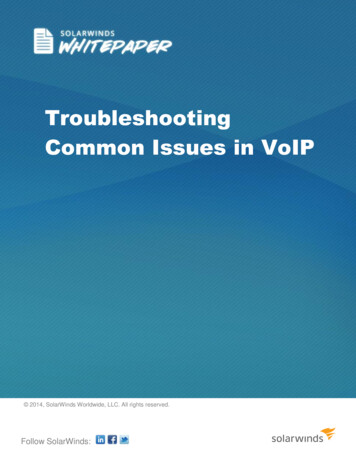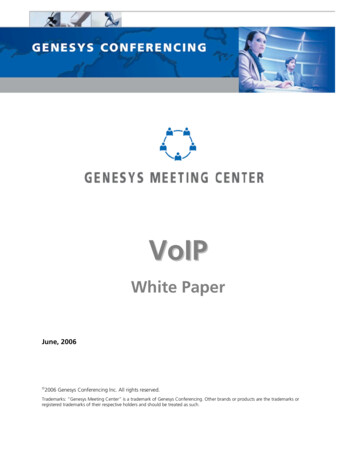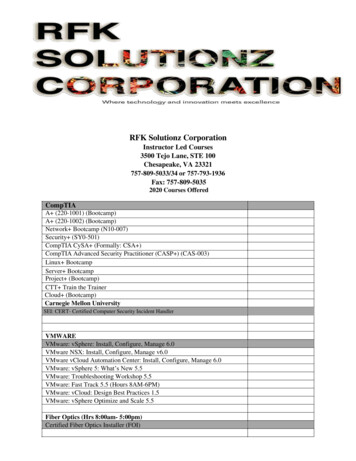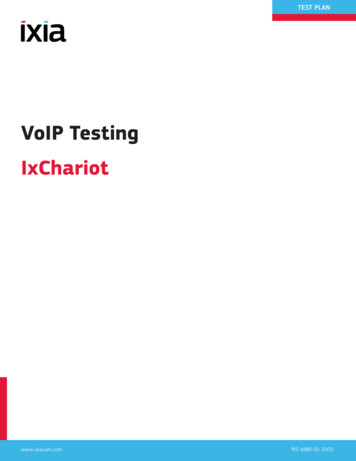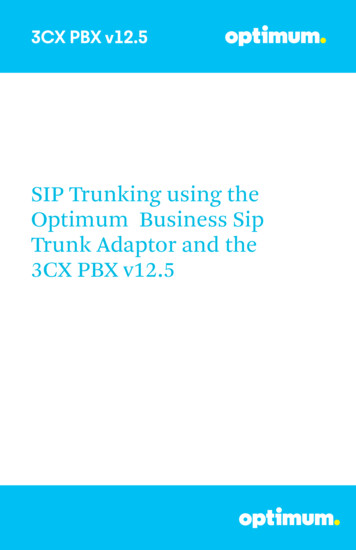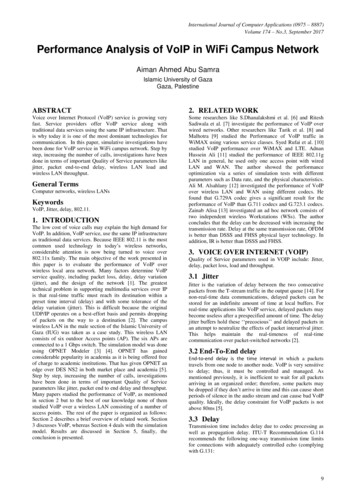
Transcription
International Journal of Computer Applications (0975 – 8887)Volume 174 – No.3, September 2017Performance Analysis of VoIP in WiFi Campus NetworkAiman Ahmed Abu SamraIslamic University of GazaGaza, PalestineABSTRACT2. RELATED WORKVoice over Internet Protocol (VoIP) service is growing veryfast. Service providers offer VoIP service along withtraditional data services using the same IP infrastructure. Thatis why today it is one of the most dominant technologies forcommunication. In this paper, simulative investigations havebeen done for VoIP service in WiFi campus network. Step bystep, increasing the number of calls, investigations have beendone in terms of important Quality of Service parameters likejitter, packet end-to-end delay, wireless LAN load andwireless LAN throughput.Some researchers like S.Dhanalakshmi et al. [6] and RiteshSadiwala et al. [7] investigate the performance of VoIP overwired networks. Other researchers like Tarik et al. [8] andMalhotra [9] studied the Performance of VoIP traffic inWiMAX using various service classes. Syed Rufai et al. [10]studied VoIP performance over WiMAX and LTE. AdnanHussein Ali [11] studied the performance of IEEE 802.11gLAN in general, he used only one access point with wiredLAN and WAN. The author showed the performanceoptimization via a series of simulation tests with differentparameters such as Data rate, and the physical characteristics.Ali M. Alsahlany [12] investigated the performance of VoIPover wireless LAN and WAN using different codecs. Hefound that G.729A codec gives a significant result for theperformance of VoIP than G.711 codecs and G.723.1 codecs.Zainab Alisa [13] investigated an ad hoc network consists oftwo independent wireless Workstations (WSs). The authorconcludes that the delay can be decreased with increasing thetransmission rate. Delay at the same transmission rate, OFDMis better than DSSS and FHSS physical layer technology. Inaddition, IR is better than DSSS and FHSS.General TermsComputer networks, wireless LANsKeywordsVoIP, Jitter, delay, 802.11.1. INTRODUCTIONThe low cost of voice calls may explain the high demand forVoIP. In addition, VoIP service, use the same IP infrastructureas traditional data services. Because IEEE 802.11 is the mostcommon used technology in today’s wireless networks,considerable attention is now being turned to voice over802.11x family. The main objective of the work presented inthis paper is to evaluate the performance of VoIP overwireless local area network. Many factors determine VoIPservice quality, including packet loss, delay, delay variation(jitter), and the design of the network [1]. The greatesttechnical problem in supporting multimedia services over IPis that real-time traffic must reach its destination within apreset time interval (delay) and with some tolerance of thedelay variation (jitter). This is difficult because the originalUDP/IP operates on a best-effort basis and permits droppingof packets on the way to a destination [2]. The campuswireless LAN in the male section of the Islamic University ofGaza (IUG) was taken as a case study. This wireless LANconsists of six outdoor Access points (AP). The six APs areconnected to a 1 Gbps switch. The simulation model was doneusing OPNET Modeler [3] [4]. OPNET has gainedconsiderable popularity in academia as it is being offered freeof charge to academic institutions. That has given OPNET anedge over DES NS2 in both market place and academia [5].Step by step, increasing the number of calls, investigationshave been done in terms of important Quality of Serviceparameters like jitter, packet end to end delay and throughput.Many papers studied the performance of VoIP, as mentionedin section 2 but to the best of our knowledge none of themstudied VoIP over a wireless LAN consisting of a number ofaccess points. The rest of the paper is organized as follows:Section 2 describes a brief overview of related work. Section3 discusses VoIP, whereas Section 4 deals with the simulationmodel. Results are discussed in Section 5, finally, theconclusion is presented.3. VOICE OVER INTERNET (VOIP)Quality of Service parameters used in VOIP include: Jitter,delay, packet loss, load and throughput.3.1 JitterJitter is the variation of delay between the two consecutivepackets from the T-stream traffic in the output queue [14]. Fornon-real-time data communications, delayed packets can bestored for an indefinite amount of time at local buffers. Forreal-time applications like VoIP service, delayed packets maybecome useless after a prespecified amount of time. The delayjitter buffers hold these ‘‘precocious’’ and delayed packets inan attempt to neutralize the effects of packet interarrival jitter.This helps maintain the real-timeness of real-timecommunication over packet-switched networks [2].3.2 End-To-End delayEnd-to-end delay is the time interval in which a packetstravels from one node to another node. VoIP is very sensitiveto delay; thus, it must be controlled and managed. Asmentioned previously, it is inefficient to wait for all packetsarriving in an organized order; therefore, some packets maybe dropped if they don’t arrive in time and this can cause shortperiods of silence in the audio stream and can cause bad VoIPquality. Ideally, the delay constraint for VoIP packets is notabove 80ms [5].3.3 DelayTransmission time includes delay due to codec processing aswell as propagation delay. ITU-T Recommendation G.114recommends the following one-way transmission time limitsfor connections with adequately controlled echo (complyingwith G.131:9
International Journal of Computer Applications (0975 – 8887)Volume 174 – No.3, September 2017 0 to 150 ms: acceptable for most user applications; 150 to 400 ms: acceptable for international connections; 400 ms: unacceptable for general network planningpurposes; however, it is recognized that in some exceptionalcases this limit will be exceeded [1] [15].3.4 Packet LossPacket loss is inevitable in IP networks and occurs for variousreasons. For example, it occurs when routers or switch workbeyond capacity or queue buffers over flow. VoIP networkpacket loss, above some threshold rate, introduces audiodistortions that cause voice quality to be decreased as the rateof packet loss increases [16].4. NETWORK MODELThe network model presents a campus wireless LAN. Thiswireless LAN consists of six outdoor Access Points (APs)connected to a one Gbps switch as shown in Figure 1. Thegeneral network topology showed in Figure 2. A number ofwireless workstations (WSs) are connected to each AP. WSsare suggested to be at the fixed place.Fig 1: The Network modelTable 1. Voice attributes and their valuesAttributeValueSilence length (seconds)Talk spurt length(seconds)Symbolic destinationnamedefaultdefaultVoice destinationEncoder schemeG.729A (Silence)Voice frames per packet1Type of serviceBest effort (0)RSVP parametersnoneTraffic mixAll discreteSignalingnoneCompression delay(seconds)Decompression delay(seconds)0.020.02Step by step, increasing the number of workstations (WSs),four scenarios were implemented, for 4,6,8 and 9 WSs at eachAP. Then the values of QoS parameters were taken. Toinvestigate the performance of VoIP with TCP on IEEE802.11g simulations were performed using OPNET Modelerv14.5. OPNET Modeler is a powerful communication systemdiscrete event simulator (DES) developed by OPNETTechnologies. OPNET Modeler 14.5 assists with the designand testing of communications protocols and networks, bysimulating network performance for wired and/or wirelessenvironments [4]. The simulation lasts 300 seconds. Theattributes that shown in Table 1 were used for the VoIPservice. Best effort type of service was used and G.729A(silence) codec as recommended by [12].5. RESULTS AND DISCUSSIONAn important parameter in determining the QoS for VoIP isits timing operations. So, the jitter and the delay will bestudied initially. The jitter values in all four scenarios areneglected. They are less than 1.3E-11. These values wereearned because the network is not congested. Figure 3 showsthe average packet end-to-end delay for the four scenarios i.e.the scenarios with 4 WSs, 6 WSs, 8 WSs and 9 WSs.Fig 2: The general network topology10
International Journal of Computer Applications (0975 – 8887)Volume 174 – No.3, September 2017Fig 3: End-To-End delayThe values of end-to-end delay, for all scenarios, are constantbecause the all scenarios have the same bit rate and thenetwork is not congested.Wireless LAN delay represents the end-to-end delay of all thepackets received by the wireless LAN MACs of all WLANnodes in the network and forwarded to the higher layer. Thisdelay includes medium access delay at the source MAC,reception of all the fragments individually, and transfer of theframes through AP if access point functionality is enabled[17] [18].Figure 4 represents the wireless LAN delay. The wirelessLAN delay values for the scenarios with 4 WSs, 6 WSs and 8WSs are very small. They are accepted and even good. Butthe wireless LAN delay for 9 WSs and 10 WSs reach 270 msand 1.2 sec respectively i.e. not accepted. Table 2 presents thevalues of the wireless LAN delay for the scenarios with 4, 6, 8and 9 WSs.Table 2. WLAN delay for the four scenariosscenario4 WSs6 WSs8 WSs9 WSsTime2 ms4 ms26 ms270 msThe load & throughput test is concerned with the receipt ofthe payload data without considering the overhead of networkagainst the load. Load represents the total load (in bits/sec)submitted to wireless LAN layers by all other higher layers inall WLAN nodes of the network. This statistic does notinclude the bits of the higher-layer packets that are dropped byWLAN MACs upon arrival and not considered fortransmission because of, for example, insufficient space left inthe higher layer packet buffer of the MAC [17] [19]. The loadcan be observed in Figure 5.Fig 4: Wireless LAN delay11
International Journal of Computer Applications (0975 – 8887)Volume 174 – No.3, September 2017Fig 5: Wireless LAN loadFig 6: Wireless LAN throughputThroughput represents the total number of bits (in bits/sec)forwarded from wireless LAN layers to higher layers in allWLAN nodes of the network [17] [19]. Throughput isrepresented in Figure 6. Increasing the number of the WSsconnected to each AP, the Load and the throughput are alsoincreased. But there is no benefit from the increase inthroughput for more than 8 WSs, because of the increase inthe wireless LAN delay, which exceeds the accepted value forVoIP.From the above figures, it can be concluded that the capacityof the campus wireless LAN in the studied case is 8 WSsusing VoIP service for each Access Point. In other words, thecapacity of the whole wireless campus LAN is 48 VoIPclients at the same time.6. CONCLUSIONIn this paper, simulative investigations have been done forVoIP in WiFi campus network using OPNET Modeler. Stepby step, increasing the number of workstations (WSs),investigations have been done in terms of important Qualityof Service parameters like jitter, packet end-to-end delay andwireless LAN load and wireless LAN throughput. Based onthe simulation results, the jitter values in all scenarios areneglected because the network is not congested. WirelessLAN delay is acceptable for the scenarios with 4, 6, and 8WSs i.e. the capacity of the campus wireless LAN in thestudied case is 8 WSs using VoIP service for each AccessPoint. The throughput of the wireless networks depends onnetwork load. But there is no benefit from the increase in12
International Journal of Computer Applications (0975 – 8887)Volume 174 – No.3, September 2017throughput for more than 8 WSs, because of the increase inthe delay, which exceeds the accepted value for VoIP. As afuture work, more types of traffic like Email, FTP and HTTPwill be added to make the case more realistic.7. REFERENCES[1] BUR GOODE, Voice Over Internet Protocol (VoIP),Invited Paper, Proceedings of the IEEE ( Volume:90, Issue: 9, Sep 2002 ), Page(s): 1495 – 1517[2] BUR GOODE, IMPLEMENTING VOICE OVER IP,2003 by John Wiley & Sons, Inc.[3]OPNET Technologies, OPNET Modeler ProductDocumentation Release 11.0, OPNET Modeler, 2005[4] tral/opnet.html?redirect opnet[5] K. Salah and A. Alkhoraidly, An OPNET-basedSimulation Approach for Deploying VoIP, InternationalJournal of Network Management Volume 16, Issue 3,Pages 159-183[6] S.Dhanalakshmi et al, Investigating The Performance OfVoip Over Ethernet Lan In Campus Network.International Journal of Recent Scientific Research Vol.6, Issue, 6, pp.4389-4394, June 2015[7] Mr. Ritesh Sadiwala, Dr. Minal Saxena” performanceEvaluation of Quality Parameters in VOIP and PSTNSystems” IRACST, Vol.5, No 5, October 2015[8] Anouari, Tarik, and Abdelkrim Haqiq. "Performanceanalysis of VoIP traffic in WiMAX using various serviceclasses." arXiv preprint arXiv:1308.0223(2013).[9]Malhotra, Jyoteesh. "Performance Evaluation ofSchedulingServicesforVoIPinWiMAXNetworks." InternationalJournalofComputerApplications71.19 (2013).[10] Syed Hamza Mehmood Rufai et al., Comparison of VoIPand Video Content Performance Over WiMAX and LTE,Simon Fraser University, CanadaIJCATM : www.ijcaonline.org[11] Adnan Hussein Ali et al., Performance Evaluation ofIEEE802.11g WLANsUsing OPNET Modeler, AmericanJournal of Engineering Research (AJER), Volume-02,Issue-12, pp-09-15[12] Ali M. Alsahlany, studied the PERFORMANCEANALYSISOFVOIPTRAFFICOVERINTEGRATING WIRELESS LAN AND WAN USINGDIFFERENT CODECS, International Journal ofWireless & Mobile Networks (IJWMN) Vol. 6, No. 3,June 2014[13] Zainab T. Alisa, Evaluating the Performance of WirelessNetwork using OPNET Modeler, International Journal ofComputer Applications (0975 – 8887) Volume 62–No.13, January 2013.[14] Zheng, Li, Liren Zhang, and Dong Xu. "Characteristicsof network delay and delay jitter and its effect on voiceover IP (VoIP)." Communications, 2001. ICC 2001.IEEE International Conference on. Vol. 1. IEEE, 2001.[15] Understanding Delay in Packet Voice rfordelaylimits[16] James, Jim H., Bing Chen, and Laurie Garrison."Implementing VoIP: a voice transmission performanceprogress report." IEEE Communications Magazine42.7(2004): 36-41.[17] .elsevier.com/9780123850591/Lab Manual/Lab 02.pdf 9/8/2017[18] Bourdoucen, H., A. Al Naamany, and A. Al Kalbani."Impact of Implementing VPN to Secure WirelessLAN." International Journal of Computer andInformation Engineering 3 (2009): 1.[19] Sari, Arif, and Behnam Rahnama. "Simulation of 802.11Physical Layer Attacks in MANET." ComputationalIntelligence, Communication Systems and Networks(CICSyN), 2013 Fifth International Conference on.IEEE, 2013.13
3. VOICE OVER INTERNET (VOIP) Quality of Service parameters used in VOIP include: Jitter, delay, packet loss, load and throughput. 3.1 Jitter Jitter is the variation of delay between the two consecutive packets from the T-stream traffic in the output queue [14]. For non-real-time data communications, delayed packets can be
